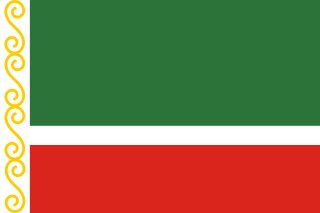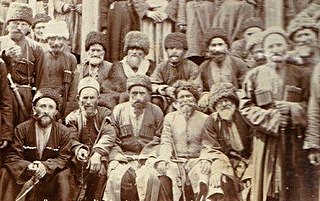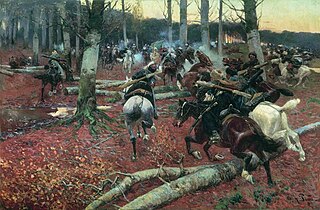
Chechnya, officially the Chechen Republic, is a republic of Russia. It is situated in the North Caucasus of Eastern Europe, between the Caspian Sea and Black Sea. The republic forms a part of the North Caucasian Federal District, and shares land borders with Georgia to its south; with the Russian republics of Dagestan, Ingushetia, and North Ossetia-Alania to its east, north, and west; and with Stavropol Krai to its northwest. After the dissolution of the Soviet Union in 1991, the Checheno-Ingush ASSR split into two parts: the Republic of Ingushetia and the Chechen Republic. The latter proclaimed the Chechen Republic of Ichkeria, which declared independence, while the former sided with Russia. Following the First Chechen War of 1994–1996 with Russia, Chechnya gained de facto independence as the Chechen Republic of Ichkeria, although de jure it remained a part of Russia. Russian federal control was restored in the Second Chechen War of 1999–2009, with Chechen politics being dominated by the former Ichkerian Mufti Akhmad Kadyrov, and later his son Ramzan Kadyrov.

A teip is a Chechen and Ingush tribal organization or clan, self-identified through descent from a common ancestor or geographic location. It is a sub-unit of the tukkhum and shahar. There are about 150 Chechen and 120 Ingush teips. Teips played an important role in the socioeconomic life of the Chechen and Ingush peoples before and during the Middle Ages, and continue to be an important cultural part to this day.
The history of Chechnya may refer to the history of the Chechens, of their land Chechnya, or of the land of Ichkeria.

The Chechens, historically also known as Kisti and Durdzuks, are a Northeast Caucasian ethnic group of the Nakh peoples native to the North Caucasus. They are the largest ethnic group in the region and refer to themselves as Nokhchiy. The vast majority of Chechens are Muslims and live in Chechnya, an autonomous republic within the Russian Federation.
Sheikh Mansur was a Chechen military commander and Islamic leader who led an anti-Russian North Caucasian resistance, known as the Sheikh Mansur Movement. He was influential in the resistance against Catherine the Great's imperialist expansion into the Caucasus during the late 18th century. Sheikh Mansur is considered the first leader of the resistance in the North Caucasus against Russian imperialism. He remains a hero of the Chechen and North Caucasian peoples in general, and their struggle for independence.

The Terek Cossack Host was a Cossack host created in 1577 from free Cossacks who resettled from the Volga to the Terek River. The local aboriginal Terek Cossacks joined this Cossack host later. In 1792 it was included in the Caucasus Line Cossack Host and separated from it again in 1860, with the capital of Vladikavkaz. In 1916 the population of the Host was 255,000 within an area of 1.9 million desyatinas.

The Caucasian War or the Caucasus War was a 19th-century military conflict between the Russian Empire and various peoples of the North Caucasus who resisted subjugation during the Russian conquest of the Caucasus. It consisted of a series of military actions waged by the Russian Imperial Army and Cossack settlers against the native inhabitants such as the Adyghe, Abaza-Abkhazians, Ubykhs, Chechens, and Dagestanis as the Tsars sought to expand.
Tukkhum is a term and system introduced in the 1960s, most notably by Soviet Chechen writer Magomet Mamakaev in 1962. This system does not properly apply to the Chechen nation and the social structure of Chechen clans.

The Nakh peoples are a group of North Caucasian peoples identified by their use of the Nakh languages and other cultural similarities. These are chiefly the ethnic Chechen, Ingush and Bats peoples of the North Caucasus, including closely related minor or historical groups.
During the 13th and 14th centuries, the Mongols launched two long, massive invasions of the territory of modern Chechnya and Ingushetia, which included the lands of Alania in the west, Simsir in the northeast, and the Georgian-allied polity of Durdzuketia in the south. They caused massive destruction and human death for the Durdzuks, but also greatly shaped the people they became afterward. However, this came at great cost to them, and the states they had built were utterly destroyed, as were their previous organized systems. These invasions are among the most significant occurrences in Chechen and Ingush history, and have had long-ranging effects on Chechnya, Ingushetia and their peoples.
Chechnya was first incorporated as a whole into the Russian Empire in 1859 after the decades-long Caucasian War. Tsarist rule was marked by a transition into modern times, including the formation of a Chechen bourgeoisie, the emergence of social movements, reorientation of the Chechen economy towards oil, heavy ethnic discrimination at the expense of Chechens and others in favor of Russians and Kuban Cossacks, and a religious transition among the Chechens towards the Qadiri tariqa of Sufism.
Isa of Ghendargen was a Chechen General during the Caucasian War, who commanded the Eastern and Central Fronts of Caucasian Imamate. He is also one of the great commanders in Chechen history. Isa was of the Ghendargnoy teip and Appaz-Nek'e.

Ramzan Adlanovich Akhmadov was a Chechen Salafi leader and a brigadier general in the Chechen Armed Forces who commanded the Southwestern Front during the Second Chechen War. He was also the founder of the Islamist organisations Islamic brigade and Urus-Martan Jamaat, which sought to establish Sharia law throughout Chechnya. Ramzan was of the Ghendargnoy teip and Appaz-Nek'e.
Aldaman Gheza was a Chechen feudal lord that lived in Cheberloy, Chechnya in the 17th century. He is a prominent figure in the region and Chechen-Ingush folklore, and celebrated as a hero that protected the Chechen borders from foreign invasions. For example, the victory at the Battle of Khachara is attributed to him as he supposedly led the Chechen forces in the battle against Avar Khanate.

Vilayet Arshtkhoy,Vilayet Arshty,Arshtinskiy Vilayet, was an Ingush administrative unit of the North Caucasian Imamate. The Naibstvo was the farthest region of the Imamate in the west and it was established on the territory of Orstkhoy society with the center being the village of Arshty.
The Battle of Endirey was a major confrontation between the Russian Empire and its allies with the Chechens and Kumyks and took place in a gorge on the Aktash River near Endirey. An army sent led by Brigadier Andrei Veterani was encircled by a combined Chechen–Kumyk force, as a result of which the corps was defeated and forced to retreat. Another detachment under Colonel Naumov broke into Endirey and destroyed it.

Aidemir Bardykhanov, also known as Aidemir Turlov was a prince from the Turlov dynasty and the Senior Prince of the Chechen principality from 1732 to his death in 1746 and was also a Khan of the Endirey Khanate. He is famous for his role in the Battle of Chechen–Aul, where he led Chechen rebels into victory against Russian troops.
Tururav II Turlov was a prince from the Turlov dynasty and the Senior Prince of the Turlov Principality from approximately the 1680s to 1690s. He was the son of Zagashtuk Turlov while his own son, Amirkhamza Turlov would become one of the future Senior Princes of the Turlov state. He succeeded Bartikhan Turlov as the Senior Prince of the Turlov Principality and was succeeded by Muhammad Turlov. Nothing is known about his reign, however.
The Koshlakov Raid was an assault on the town of Koshlakov by Chechen highlanders from the Shatoy tribe, resulting in a victory for the raiders.
Kazy Khan was an 18th–century Chechen Qadi from the Shatoy tribe, and, according to some documents, the ruler of the Shatoy Federation. He was also a negotiator and messenger to Nader Shah.










